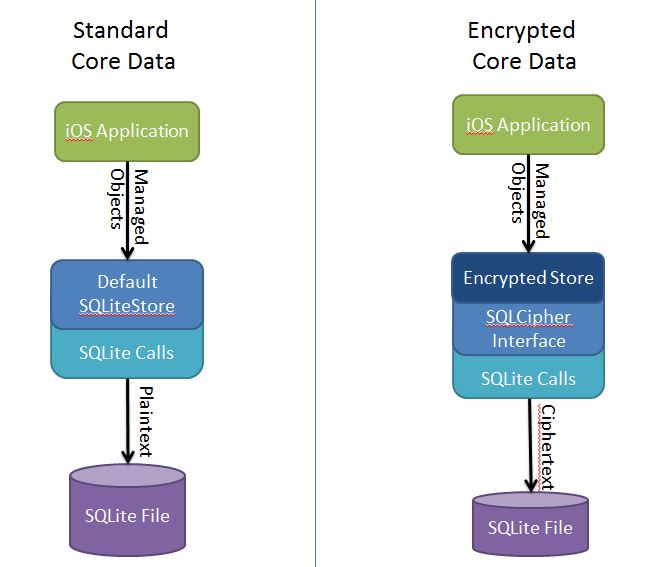EncryptedCoreData 3.1
| TestsTested | ✓ |
| LangLanguage | Obj-CObjective C |
| License | Custom |
| ReleasedLast Release | May 2016 |
Maintained by Fernando Arellano, Daniel Broad.
- By
- MITRE
Encrypted Core Data SQLite Store 
Provides a Core Data store that encrypts all data that is persisted. Besides the initial setup, the usage is exactly the same as Core Data and can be used in existing projects that use Core Data.
Vulnerabilities Addressed
- SQLite database is not encrypted, contents are in plain text
- CWE-311: Missing Encryption of Sensitive Data
- SQLite database file protected with 4 digit system passcode
- CWE-326: Inadequate Encryption Strength
- SRG-APP-000129-MAPP-000029 Severity-CAT II: The mobile application must implement automated mechanisms to enforce access control restrictions which are not provided by the operating system
Project Setup
- When creating the project make sure Use Core Data is selected
- Switch into your project's root directory and checkout the encrypted-core-data project code
cd ~/Documents/code/YourApp
git clone https://github.com/project-imas/encrypted-core-data.git
- Click on the top level Project item and add files ("option-command-a")
Navigate to encrypted-core-data, highlight Incremental Store, and click Add
SQLCipher is added as a git submodule within ECD. A
git submodule initandgit submodule updateshould populate the sqlcipher submodule directory, where thesqlcipher.xcodeprojcan be found and added to your project.- To use CommonCrypto with SQLCipher in Xcode:
- add the compiler flags
-DSQLCIPHER_CRYPTO_CCand-DSQLITE_HAS_CODECunder the sqlcipher project settings > Build Settings > Custom Compiler Flags > Other C Flags - Under your application's project settings > Build Phases, add
sqlcipherto Target Dependencies, andlibsqlcipher.aandSecurity.frameworkto Link Binary With Libraries.
- add the compiler flags
- Note: Along with the move to CommonCrypto, we've updated the version of SQLCipher included as a submodule from v2.0.6 to v3.1.0. Databases created with v2.0.6 will not be able to be read directly by v3.1.0, and support for legacy database migration is not yet supported by ECD.
Installation via CocoaPod
- If you don't already have CocoaPods installed, do
$ sudo gem install cocoapodsin your terminal. (See the CocoaPods website for details.) - In your project directory, do
pod initto create a Podfile. - Add
pod 'EncryptedCoreData', :git => 'https://github.com/project-imas/encrypted-core-data.git'to your Podfile - Run
pod install - In your application delegate source file (AppDelegate.m), add
#import "EncryptedStore.h"
Using EncryptedStore
EncryptedStore is known to work successfully on iOS versions 6.0 through 9.2.
If you wish to set a custom cache size and/or custom database URL: create an NSDictionary to set the options for your EncryptedStore, replacing customPasscode, customCacheSize, and/or customDatabaseURL:
NSDictionary *options = @{ EncryptedStorePassphraseKey: (NSString *) customPasscode,
EncryptedStoreCacheSize: (NSNumber *) customCacheSize,
EncryptedStoreDatabaseLocation: (NSURL *) customDatabaseURL
};In your application delegate source file (i.e. AppDelegate.m) you should see
NSPersistentStoreCoordinator *coordinator = [self persistentStoreCoordinator];If you created an NSDictionary with custom options, replace that line with
NSPersistentStoreCoordinator *coordinator = [EncryptedStore makeStoreWithOptions:options managedObjectModel:[self managedObjectModel]];Otherwise, replace that line with:
NSPersistentStoreCoordinator *coordinator = [EncryptedStore makeStore:[self managedObjectModel]:@"SOME_PASSCODE"];making sure to replace "SOME_PASSCODE" with a passcode of your own.
Also in the same file add an import for EncryptedStore.h:
#import "EncryptedStore.h"If there are issues you can add -com.apple.CoreData.SQLDebug 1 to see all statements encryted-cored-data generates be logged.
Features
- One-to-one relationships
- One-to-many relationships
- Many-to-Many relationships (NEW)
- Predicates
- Inherited entities
Missing features and known bugs are maintained on the issue tracker
Diagram
Below is a diagram showing the differences between NSSQLiteStore and EncryptedStore. Note that actual the SQLite calls are coupled fairly strongly with the layer wrapping it:

Strings Comparison
Below is the output of doing the unix strings command on a sample applications .sqlite file. As you can see, the default persistence store leaves all information in plaintext:

License
Copyright 2012 - 2014 The MITRE Corporation, All Rights Reserved.
Licensed under the Apache License, Version 2.0 (the "License"); you may not use this work except in compliance with the License. You may obtain a copy of the License at
http://www.apache.org/licenses/LICENSE-2.0
Unless required by applicable law or agreed to in writing, software distributed under the License is distributed on an "AS IS" BASIS, WITHOUT WARRANTIES OR CONDITIONS OF ANY KIND, either express or implied. See the License for the specific language governing permissions and limitations under the License.